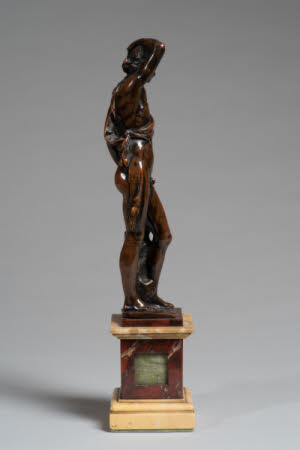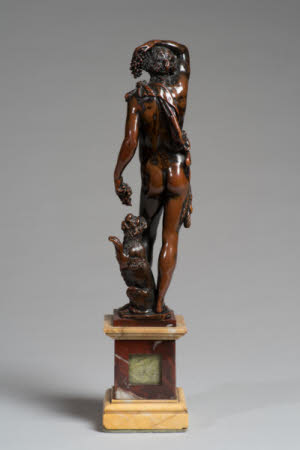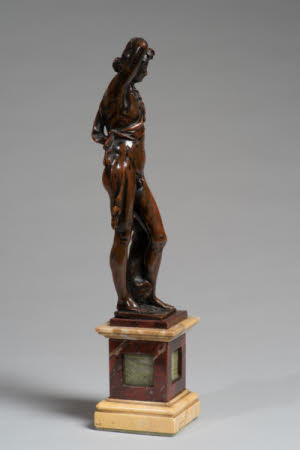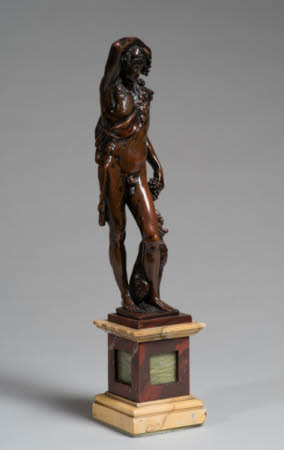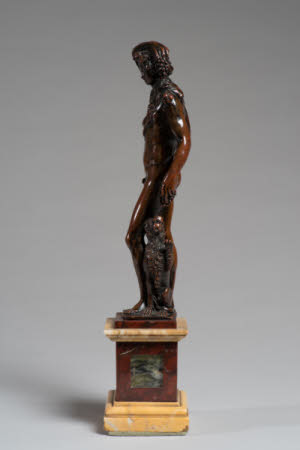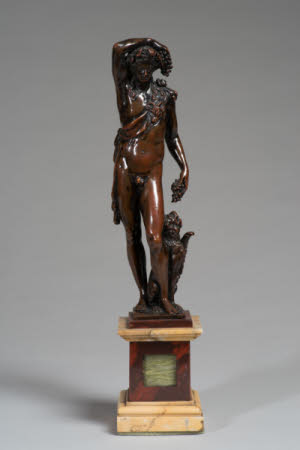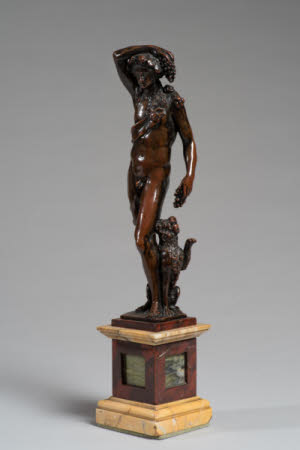Bacchus with a Panther
French School
Category
Art / Sculpture
Date
circa 1580 - 1620
Materials
Bronze on marble
Measurements
320 mm (Height)
Place of origin
France
Order this imageCollection
Anglesey Abbey, Cambridgeshire
NT 515029
Summary
Bronze, Bacchus with a Panther, French School, c. 1580-1620. A bronze figure of Bacchus, the god of wine, with a panther which is eating grapes from the god’s hand. Bacchus is depicted as a slim slightly effeminate youth, naked except for a ram’s hide which is looped over his left shoulder and falls down his right side. His right hand, held above his head, holds a bunch of grapes, whilst another bunch dangles from his left hand. A panther is seated just behind Bacchus’s left leg and reaches up for the grapes, one paw in the air. On a small integral base, in turn set on a larger later rectangular bronze base. Mounted on a rectangular base made from various coloured marbles. This very beautiful and refined bronze figure was made in France, probably around 1600.
Full description
The bronze is loosely based on an antique marble statue of a faun with a panther, itself derived from a statue of the god Apollo, known as the Lycean Apollo, made by the great 5th-century B.C. Greek sculptor Praxiteles. The key features of Praxiteles’ model were the contrapposto pose of the god, with his left leg brought forward, and the resting of his right hand upon his head. The faun with the panther is known in a large number of variants from the ancient world (Stephan F. Schroder, Römische Bacchusbilder in der Tradition des Apollon Lykeios, Rome 1989), among the best-known of which in the Renaissance period was a statue now in the Galleria degli Uffizi, Florence, but once in the collection of Cardinal Andrea della Valle (1463-1534) in Rome (Phyllis Pray Bober and Ruth Rubinstein, Renaissance Artists and Antique Sculpture, London 1986, p. 108, no. 73). In the Roman marble in the Uffizi, the faun lifts his right hand high above his head, whilst on his left side is a tree trunk, behind which the panther lurks. The tree trunk was needed as a support for a large marble figure, but since it is not necessary for a small bronze, it was dispensed with by the maker of this elegant variant, in which the figure of Bacchus is altogether more svelte. Unlike the antique marble, his right arm is placed above his head as in the Lycean Apollo and, whereas the marble faun looks upward, Bacchus looks downwards, thus connecting more clearly with the charming motif of the seated panther reaching up towards the bunch of grapes. The ram’s head on the skin glares demoniacally out, reminding the spectator of the pagan world in which Bacchus, the god of wine, and his followers had a role. The bronze is exquisitely finished, the flesh areas carefully polished, the ram’s fleece and the hide of the panther both stippled. There are traces of a golden colour down the left flank of Bacchus, whilst other this was originally applied a blackish lacquer, now mostly lost. The figure is known in several casts. Others are in: Kestner-Museum, Hanover (Inv. 1952.119. Anette Brunner, Renaissancen: Antikenrezeption in der Angewadten Kunst des 15. Bis 19. Jahrhunderts, Hanover 2003, pp. 41-42); Residenzmuseum, Munich (Inv. F.V. III – Br. A. 71. Hans Weihrauch, Bayerisches Nationalmuseum, Munich. Die Bildwerke in Bronze und in anderen Metallen, Munich 1956, pp. 210-12, no. 266); Metropolitan Museum of Art, New York (Inv. 32.100.190; Inv. 1982.60.99. James D. Draper, The Jack and Belle Linsky Collection in the Metropolitan Museum of Art, New York 1984, p. 152, no. 66); Nationalmuseum, Stockholm (Inv. NM Sk 330. First recorded in 1777. Lars Olof Larsson, European Bronzes 1450–1700, Stockholm 1992, pp. 128-29, no. 55); Robert H. Smith Collection, Washington (Anthony Radcliffe and Nicholas Penny, Art of the Renaissance Bronze 1500–1650: The Robert H. Smith Collection, London 2004, pp. 230-33, no. 41). The different versions vary considerably in quality and in details. The refined version at Anglesey Abbey seems closest in handling and quality to the version from the Linsky collection in the Metropolitan Museum, with similar working of the surface of the ram’s skin, the little circles at the end of each individual grape, or Bacchus’s hairband, which is thinner in these versions, allowing more of his hair to be seen above it. The figure has generally been thought to be Italian in origin, perhaps a Florentine work from the second half of the sixteenth century, made by a follower of the goldsmith sculptor Benvenuto Cellini (1500-71). More recently, however, it has been associated with the sophisticated small bronze figures being made in France around this time, by the sculptor Barthélemy Prieur (1536-1611) and his followers. Although the Bacchus has been attributed to Prieur himself (e.g. Maraike Bückling, Die Negervenus, Frankfurt 1991, pp. 41-44, Abb. 30), it is not entirely typical of the sculptor’s style, which can be seen for example in the bronze figures of a Seated Woman combing her hair at Anglesey Abbey (NT 515010). Another important small French bronze from this period at Anglesey is the Pluto and Cerberus (NT 515019); there are rather close parallels between the three-headed dog and the panther. The Bacchus with a Panther seems originally to have had the sort of dark red translucent varnish typical of French small bronzes from the period around 1600, which can be seen in a much better preserved form on the Pluto. An example of the Bacchus with a Panther may be seen in a painting in the National Gallery, London, depicting Cognoscenti in a Picture Gallery, painted in the Netherlands around 1620 (NG1287). There is a colossal Roman marble version of the same model at Anglesey Abbey (NT 516675). Jeremy Warren 2019
Provenance
Bequeathed to the National Trust by Huttleston Rogers Broughton, 1st Lord Fairhaven (1896-1966) with the house and the rest of the contents.
Credit line
Anglesey Abbey, The Fairhaven Collection (The National Trust)
Makers and roles
French School, sculptor
References
Christie, Manson & Woods 1971: The National Trust, Anglesey Abbey, Cambridge. Inventory: Furniture, Textiles, Porcelain, Bronzes, Sculpture and Garden Ornaments’, 1971, p. 138.
